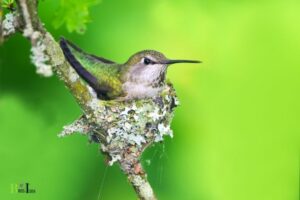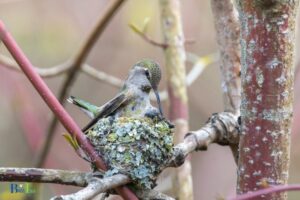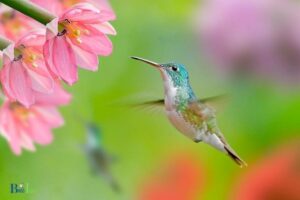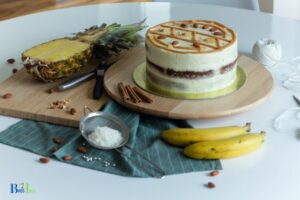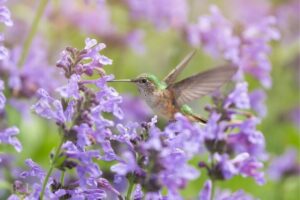How to Make Hummingbird Nectar? 5 Step’s!
Making hummingbird nectar involves creating a simple sugar water solution that mimics the natural nectar found in flowers, which hummingbirds feed on.
Hummingbird nectar is a vital source of energy and nutrients for these small, fast-flying birds. By providing a homemade version, you can help support your local hummingbird population and enjoy the beauty of these fascinating creatures in your own backyard.
To make hummingbird nectar, start by combining four parts water with one part white granulated sugar in a saucepan.
Heat the mixture over low heat, stirring occasionally, until the sugar has completely dissolved. Once the sugar has dissolved, remove the saucepan from heat and allow the nectar to cool to room temperature.
Do not add any additives such as honey, artificial sweeteners, or red dye to the nectar, as these can be harmful to hummingbirds. Fill your hummingbird feeder with the cooled nectar and place it in a shady spot outside.
Be sure to clean and replace the nectar in your feeder every 3-5 days to prevent bacterial growth and maintain a healthy food source for the hummingbirds.
5 Easy Step’s on Making Hummingbird Nectar
| Step | Ingredients | Instructions |
|---|---|---|
| 1 | 4 cups of water | Boil water in a pot or kettle |
| 2 | 1 cup of granulated sugar | Remove the water from heat and add sugar, stirring until it completely dissolves |
| 3 | – | Allow the sugar water to cool down to room temperature |
| 4 | – | Fill the hummingbird feeder with the prepared sugar water |
| 5 | – | Hang the feeder in a shaded area and clean/replace the nectar every few days |
Note: Do not use honey, artificial sweeteners, or food coloring, as they may harm the hummingbirds.
Key Takeaway
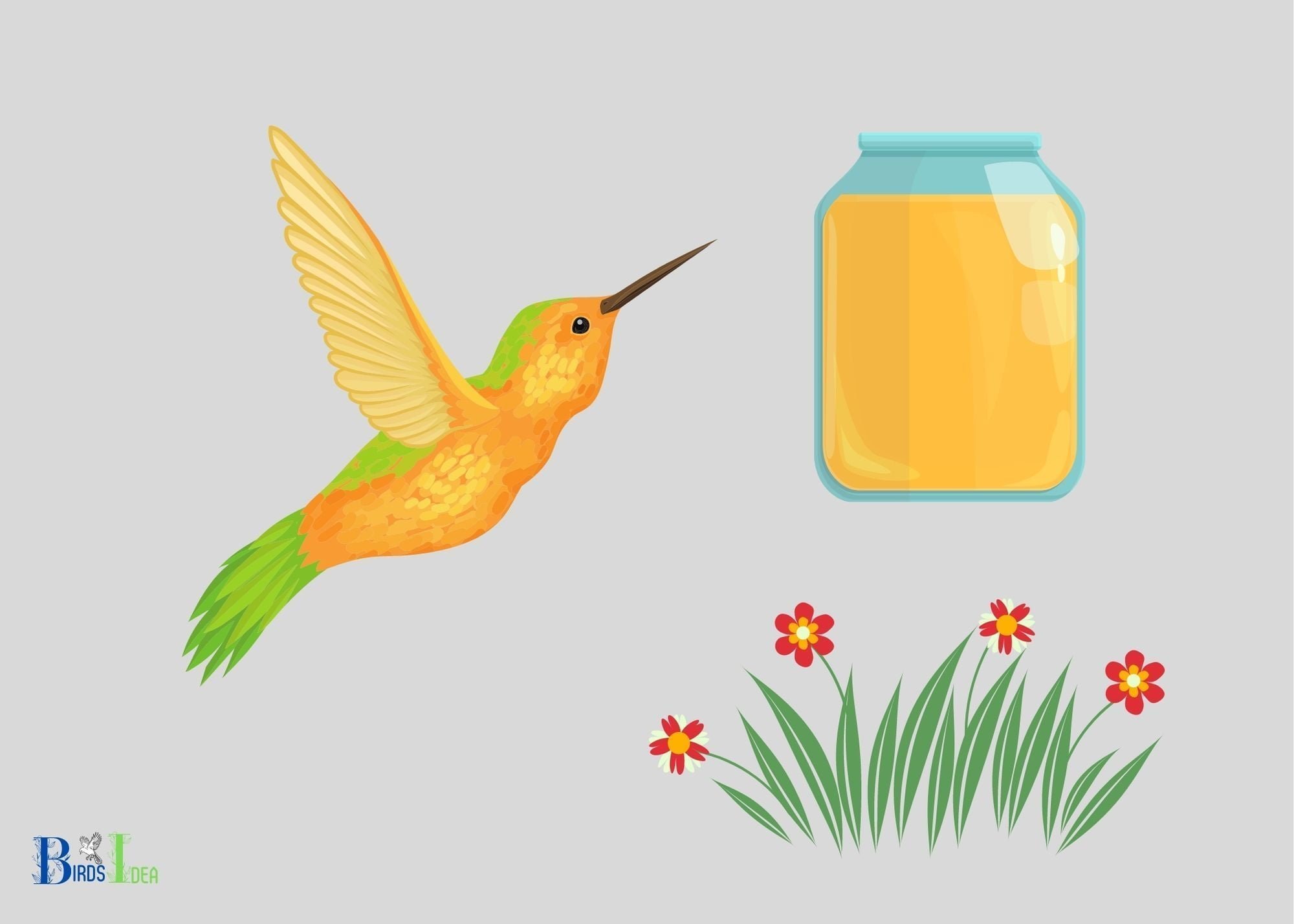
Five Facts About: Making Hummingbird Nectar
Understanding The Basics Of Hummingbird Nectar
Hummingbirds are a delightful sight in any garden, and providing them with food is a popular way to attract them.
However, knowing how to make hummingbird nectar and the important factors associated with it is critical.
In this section, we’ll discuss the essentials of hummingbird nectar, such as the nutritional requirements of these birds and the right sugar-water ratio to use.
Provide A Concise Explanation Of What Hummingbird Nectar Is And The Nutritional Requirements Of Hummingbirds To Thrive.
Hummingbird nectar is a simple mixture of sugar and water that provides hummingbirds with the necessary nutrients to survive.
Here are some essential things to bear in mind:
- Hummingbirds utilize glucose as their primary energy source, making sugar (sucrose) the most important nutrient for them.
- Hummingbirds also require minerals, amino acids, and various nutrients to maintain their energy levels. However, they can obtain these from their daily diet and insect intake.
- The food that hummingbirds consume affects their breeding, migration, and overall susceptibility to environmental stress. Nutritious nectar is essential for their good health.
Mention The Importance Of Providing The Right Sugar-Water Ratio To Attract Hummingbirds To Your Garden.
Hummingbirds are drawn to flowers that have high sugar concentrations because they provide them with the energy they require.
As a result, the nectar’s sugar-water ratio is critical if you want to attract these birds to your garden.
- A good place to start when making nectar is a four-to-one water-to-sugar ratio.
- Never use honey since it promotes bacterial growth and can cause health problems for hummingbirds.
- Use granulated cane sugar in your nectar rather than powdered sugar, organic sugar, or beet sugar.
- Regular cleaning of the feeders and a change of nectar every three to four days during the summer months is necessary to maintain the freshness of the food and prevent disease.
A basic grasp of hummingbird nectar is essential to keep these birds delighted, energized and healthy.
Creating the perfect nectar is simple once you understand the basics, and it is an excellent way to provide a welcoming environment for our little feathered friends.
How To Make Hummingbird Nectar: Step-By-Step Guide
Hummingbirds are delightful and fascinating creatures that can bring joy and beauty to any garden.
One way to attract them to your outdoor space is by offering nectar, which is a mixture of sugar and water that mimics the natural nectar found in flowers.
We will provide you with a step-by-step guide on how to make hummingbird nectar at home, including the ingredients needed, tools required, sugar-water ratio, and sterilization technique.
Ingredients And Tools Required
- White granulated sugar
- Filtered water
- Saucepan
- Stirring spoon
- Measuring cup
- Funnel
- Glass jar or bottle
- Hummingbird feeder
Sugar-Water Ratio
Mixing the right amount of sugar and water is crucial to making hummingbird nectar. Follow the recommended ratio of 1 part sugar to 4 parts water.
Sterilization Technique
It’s essential to sterilize your feeder and utensils before you prepare the nectar to ensure the safety and well-being of hummingbirds.
Here’s how you can do it:
- Wash your feeder and utensils with soap and hot water.
- Rinse thoroughly with hot water.
- Submerge them in boiling water for at least 10 minutes.
- Let them air-dry before using.
Tips For Creating Nectar
- Use filtered water to ensure that the nectar is free of contaminants that can harm the hummingbirds.
- Use only white granulated sugar, and avoid using substitutes such as honey or brown sugar, as they can be harmful.
- Boil the mixture for a few minutes to kill any bacteria or mold that may cause the nectar to spoil quickly.
- Allow the nectar to cool before filling up your feeder.
- Replace the nectar every two to three days, especially in hot weather, to prevent fermentation and mold growth.
- Store unused nectar in the refrigerator for up to a week in a sealed glass jar or bottle.
By using these simple instructions, you can create a safe and delightful environment for hummingbirds to visit your garden. Happy bird watching!
Tips For Choosing The Right Feeder For Hummingbirds
Choosing The Right Hummingbird Feeder: The Key To Attracting These Beautiful Birds
Hummingbirds need a constant supply of nectar to maintain their high metabolism and energy levels. As such, providing them with a good hummingbird feeder is the perfect way to keep them coming back to your garden.
But with so many types of feeders available, selecting the right one can be challenging.
Here are a few tips to guide you in making the best choice:
What Types Of Feeders Do Hummingbirds Prefer?
Choosing the right feeder for your garden will depend on the type of hummingbirds you want to attract.
Here are the three most commonly used types of hummingbird feeders:
- Bottle feeders: This type of feeder is shaped like a bottle and has a spout where the nectar flows out. They are popular for being easy to clean, refill, and prevent bees and wasps from accessing the nectar.
- Saucer feeders: These feeders have a shallow dish where the nectar is poured, and the hummingbirds can drink through the ports on the sides. They are great for attracting multiple birds but require frequent cleaning and refilling.
- Tube feeders: Tube feeders are similar to bottle feeders, but the tube-shaped dispenser is smaller, and the feeding ports are usually located on the base. These feeders are great for attracting one or two hummingbirds and prevent larger birds from accessing the nectar.
Different Materials Used For Feeders
Hummingbird feeders can be made from various materials, such as glass, plastic, metal, or ceramic.
Some of the most common materials used include:
- Glass: Glass feeders are popular for their durability, ease of cleaning, and their uv-resistant properties that prevent the nectar from spoiling quickly.
- Plastic: Plastic feeders are lightweight and affordable, but they tend to fade, discolor, and crack quickly under the sun’s heat.
- Metal: Metal feeders are sturdy and durable but can rust over time.
- Ceramic: Ceramic feeders are beautiful and decorative, but they can be expensive and shatter easily.
Tips For Choosing The Right Feeder For Your Garden
Once you have decided on the type of feeder and its materials, it’s essential to consider other factors.
Here are some tips to help you choose the right hummingbird feeder for your garden:
- Size: The size of the feeder should match the number of hummingbirds you expect to visit. A large feeder will attract many birds and might require frequent cleaning and refilling, while a smaller one is perfect for attracting one or two hummingbirds.
- Placement: Hummingbird feeders should be placed in an open, shady area, away from direct sunlight or strong winds. The feeder should also be hung higher than the surrounding foliage and should not be near any human or pet traffic.
- Maintenance: The feeder should be cleaned and refilled every three to four days, or sooner if the nectar appears cloudy or moldy. It’s also essential to ensure the feeder is free from debris, such as leaves, pollen, or dirt, that can spoil the nectar.
By choosing the right feeder, you can attract these beautiful birds to your garden and enjoy their delightful presence.
Remember to maintain the feeder regularly, and you’ll have happy and healthy hummingbirds buzzing around in no time!
Best Practices For Attracting Hummingbirds To Your Garden
Hummingbirds are fascinating creatures that are known for their vibrant colors, hovering flight, and swift movements. These tiny birds are a delight to watch, but how do you attract them to your garden?
In this post, we’ll explore the best practices for attracting hummingbirds to your garden, including the type of flowers, plants, and trees to include, the use of birdbaths, and other resources that hummingbirds love.
We’ll also discuss the most common species of hummingbirds and their preferred habitats.
Creating A Hummingbird-Friendly Environment
Hummingbirds are attracted to gardens that are rich in nectar-producing flowers, native plants, and trees.
To create a hummingbird-friendly environment, consider the following:
- Plant flowers that are rich in nectar, such as bee balm, fuchsia, salvia, and trumpet vine, among others.
- Include native plants in your garden, as they provide a reliable source of food for hummingbirds.
- Plant trees and shrubs that provide shade and shelter, such as oak, maple, and willow trees.
- Install birdbaths that are shallow and contain fresh, clean water. Make sure to change the water at least once a week to prevent the buildup of harmful bacteria.
- Offer hummingbirds a source of protein by hanging a sugar water feeder. Be sure to clean the feeder at least once a week to prevent the growth of mold and mildew.
The Most Common Species Of Hummingbirds
There are several species of hummingbirds, each with its unique characteristics and preferred habitat.
Some of the most common species include:
- Ruby-throated hummingbird: This bird is found in the eastern part of north america, and it migrates to central america during the winter. It is attracted to red flowers and is known for its metallic green feathers.
- Anna’s hummingbird: This bird is found in the western part of north america, and it is known for its iridescent pink and green feathers. It prefers to nest in evergreen trees and is attracted to red or orange flowers.
- Broad-tailed hummingbird: This bird is found in the western part of north america, and it is known for its metallic green feathers and distinctive whistle. It prefers to nest in coniferous trees and is attracted to flowers that are red or pink.
Attracting hummingbirds to your garden requires creating a hummingbird-friendly environment that includes nectar-producing flowers, native plants, trees, and other resources that hummingbirds love.
By following these best practices, you can enjoy the beauty of these tiny creatures in your garden all year round.
FAQ About How To Make Hummingbird Nectar
How Do I Make Hummingbird Nectar?
How Often Should I Change The Nectar?
What Type Of Sugar Should I Use?
Can I Add Food Coloring To The Nectar?
How Do I Clean The Feeder?
Conclusion
As a bird lover, hummingbirds are some of the most fascinating creatures you can watch.
By learning how to make hummingbird nectar, you can make your yard or garden more hospitable to these little friends, and help ensure their continued survival.
It’s not a difficult process and doesn’t require a lot of your time or money. In fact, all you need is just some sugar and water mixed in the right proportions to get started.
Remember, the quality of the nectar can directly affect the number and health of hummingbirds.
Take proper care in making and storing it, and avoid using food coloring or honey. By following these simple guidelines, you can easily attract hummingbirds and bring joy and wonder to your life. So, what are you waiting for?
Prepare delicious nectar and get ready to enjoy the birds’ company!

